But First, A Short Story
|
| < Day Day Up > |
|
Perplexed One sat listening to the professor drone on about C++ pointers. He tried hard to stay awake but couldn’t and his head dropped to the desk with a dull thud. He was soon fast asleep.

Droning Professor

Perplexed One

Fast Asleep!
Poor Perplexed One. It looked as if pointers were about to get the best of him, but alas, he was roused from his peaceful state by the sound of cats screeching and dogs howling! Could it be? Yes, it’s C++ Man!
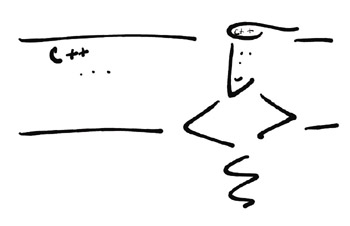
C++ Man
Perplexed One looked up to see C++ Man hovering where the droning professor once stood.
“Tell me Perplexed One, why are pointers putting you to sleep?” C++ Man asked.
“I just don’t get’em...” Perplexed One answered, nervously looking around the room wondering where all the other students had disappeared to.
“Don’t let pointers get you down, they’re really quite simple. Tell you what, write down all your questions about pointers and I’ll answer each one.
Perplexed One agreed and before long he handed C++ Man the following list:
What is an object?
What is a memory address?
How do you determine an object’s memory address?
What is a pointer?
How do you declare a pointer?
How do you access the object a pointer points to?
How do you create objects dynamically with the new operator?
How do you delete dynamically created objects with the delete operator?
What’s the difference between a pointer and a reference?
How do you declare and use references?
“These are great questions Perplexed One” C++ Man said as he poured over the list. “Let’s get started right away beginning with the first question!”
Perplexed One agreed excitedly and took out a piece of paper to take notes.
What is an object?
According to the ANSI C++ standard an object is a region of storage. An object can be a fundamental data type like an integer, char, etc. In the case of fundamental data types the regions of memory occupied by each data type are set by the environment. For instance, on a 32-bit computer with a 32-bit wide memory organization, an integer will occupy four contiguous bytes. Thus, an integer object occupies a region of memory four bytes wide.
Objects can be user-defined or abstract data types as well. Abstract data types are types you create by combining fundamental data types or other abstract data types in order to model the problem you are trying to solve on the computer. Most abstract data types will be either structures or classes. The region of memory occupied by an abstract data type is dictated by its composition. Abstract data types are discussed in detail in chapter 10.
An object can be created in three ways:
-
by definition,
-
by using the new or new[] operator,
-
or by the compiler when required.
C++ Man waved his hand at the board causing the following code to appear:
Listing 7.1: integer objects
1 int a = 1, b = 2; 2 3 cout<<"a = "<<a<<endl; 4 cout<<"b = "<<b<<endl;
In this example, Perplexed One, there are two integer objects being created via definition. The variable names a and b are NOT the objects, but the identifiers that become bound to a region of memory at compile time. The process of associating an identifier with a memory location is called binding. In this case the size of the memory region associated with each of the variables a and b is four bytes which is the size of an integer object.

“So you see Perplexed One, an object occupies a region of memory. Objects can be simple data types and occupy only a small amount of memory or they can be complex data types and occupy large amounts of storage. While your computer is running, memory is filled with many different kinds of objects of all different sizes.”“Remember, identifier names appearing in your source code are bound to their object locations during the compilation process. ”
“Thanks C++ Man! I think I finally understand the concept of objects. I always used to confuse the identifier names with the objects they represented.”
Perplexed One scribbled a few more notes then looked up at C++ Man. “OK C++ Man, I’m ready to discuss the next question on the list!”

“Great, Perplexed One! Let’s do it.”
What is a memory address?
C++ Man waved his hand at the board causing the following diagram to appear:
“Here’s a simple diagram showing the arrangement of computer memory Perplexed One. Memory is essentially an array of byte addressable elements in which binary values can be stored. Memory addresses start at zero and go up to however much memory you have in your computer. For instance, a computer with 256 megabytes of main memory has more storage, and therefore more byte addressable storage elements, than a computer with only 128 megabytes of memory.”
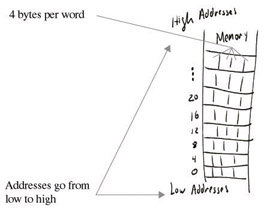
Figure 7-1: Memory
“If you recall from chapter 4, the hardware architecture of the computer system dictates how physical memory is arranged and accessed, but here we will assume that the word size is 32 bits. Looking at figure 7-1, memory starting at address 0 contains the four bytes with addresses 0, 1, 2, and 3 for a total of 32 bits. The 32-bit memory words are aligned on addresses divisible by 4, which is why the addresses 0, 4, 8, 12, etc., are going up the left side of memory in the diagram.”
“Figure 7-2 shows another way of representing memory that reinforces the idea that it is a contiguous array of elements.

Figure 7-2: Another Way To Represent Memory
Figure 7-2 also shows the memory initialized with two integer values. The integer object beginning at address 0 has a value of 1. The second integer object begins at address 4 and contains the value 2. This way of thinking of memory will come in handy when you learn about arrays in chapter 8.”
Perplexed One studied the two diagrams for a while. “Why did you use hexadecimal A in figure 7-2 to represent the address 10?”
“Good question Perplexed One!” C++ Man answered. “You’ll find it helpful in your studies of C++, and computers in general, to become accustomed to using hexadecimal. It’s easier to work with than large decimal numbers. Figure 7-3 is another diagram of memory using hexadecimal addresses.”
C++ Man lifted his pinky finger and figure 7-3 appeared on the board.
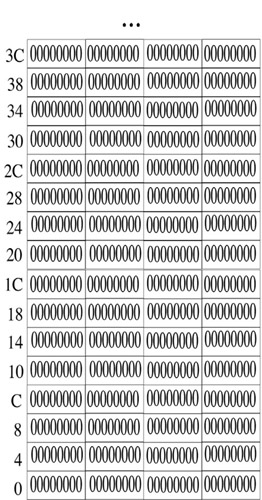
Figure 7-3: Hexadecimal Addressing

“So you see, Perplexed One, all objects in memory are accessible via an address. The addresses go from low to high and are organized according to the hardware architecture of the computer. A large object may span several addresses but have only one starting address.”
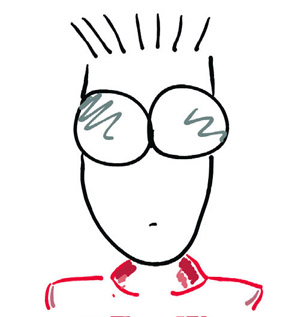
Perplexed One looked up from his notes.“This is cool. I was totally lost but now I understand the whole addressing thing.”
C++ Man beamed with pride. “Are you ready to talk about the next question Perplexed One?” he asked.
“Ready! Perplexed One replied.”
How do you determine an object’s memory address?
“An object’s memory location can be determined by using the & operator” C++ Man said. Perplexed One looked even more perplexed.
“What do you call & operator?” he asked, pencil ready to record C++ Man’s answer.
“I call it the ‘address-of’ operator” C++ Man replied, waving his hand in the direction of the board. “Let’s see how it works.”
Listing 7.2: Using & operator
1 int a = 3; 2 3 cout<<" a = "<<a<<endl; 4 cout<<"Address of a = "<<&a<<endl;
“In this example, an integer variable named a is declared and defined. Remember, definition is one way objects are created in memory. On line 3 the value of a is being printed while on line 4 the & operator is applied to the variable a in order to determine the address of the object to which the identifier a is bound to. Let’s disassemble this code and study it before running the program. The listing has been edited to make it easier to read!”
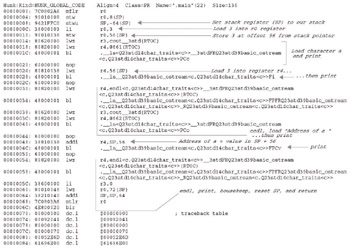
Listing 7.1: Example 7.2 Disassembled
“Running example 7.2 can produce different results, depending on what other programs are running on the computer at the same time. Figure 7-4 shows the results of running the program from the CodeWarrior programming environment.”

Figure 7-4: Running Example 7.2 with CodeWarrior
“Notice here, Perplexed One, that the address of a is shown to be 0x18da0078. Shutting down all other programs and then running example 7.2 again produced the results shown in figure 7-5.”

Figure 7-5: Running Example 7.2 Alone
“Notice in figure 7-5 that the address of a has changed to 0x19f72078. If you try this experiment on your computer at home, Perplexed One, you will get different results from those shown here.”

“The disassembled code shown in listing 7-1 shows that the integer object of example 7.2 will always be located at an offset 56 bytes from the value of the stack. This could be anywhere in main memory depending on where the program loads.“
Luckily, you don’t have to worry about the actual addresses. That’s the job of the operating system. The important thing to remember is that the & operator will return the address of an object’s memory location, whatever that address may be.”
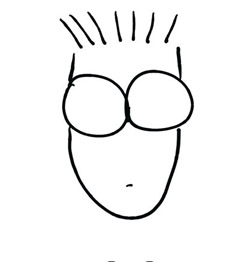
Perplexed One quickly summarized what he had learned so far. “OK, an object is a region of memory, and all objects have an address that can be determined by using the & operator.”
“That’s great Perplexed One!” C++ Man said smiling. “Now that you understand the foundation material it’s time to talk about pointers for real. Are you ready?”
“Ready!” Perplexed One said, taking out another piece of paper.
What is a pointer?
C++ Man sneezed, causing the following diagram to appear on the board:
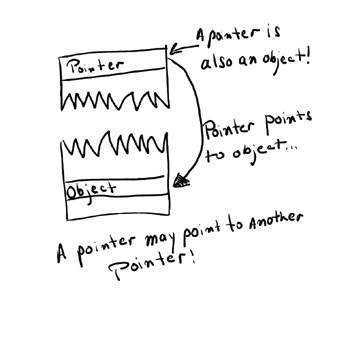
Figure 7-6: Pointer
“I’ll begin with a definition of a pointer and then explain in greater detail” C++ Man said floating from one end of the board to the other.
“A pointer is a variable that holds a memory address. The important part of this definition is the word variable. You can assign an object’s address to a pointer variable and later, change the contents of the pointer to point to some other object.”
“When a pointer contains the address of an object located somewhere in memory, the pointer is said to point to that object, hence the term pointer.”
“Pointer variables are all the same size, which is the size of the address bus. If the machine you are using has a 32-bit address bus, then a pointer will be 4 bytes long. However, a pointer can only contain addresses to objects of its declared type. For instance, a pointer to float objects can’t have the address of integer objects assigned to it. The reason for this is that the compiler needs to know what size objects a pointer is pointing to.”
“Pointers can point to other pointers, that is, a pointer can contain the address of a pointer.”

“Remember, Perplexed One, that a pointer is simply a variable that can hold an object’s address. Because it’s a variable, the address a pointer contains can be changed, just like any other variable.”

“I see.” said Perplexed One, star-ing at the diagram on the board. “But how do you tell a pointer what size objects it can point to?”
“That’s an excellent question!” C++ Man said, “And it’s the next one on your list!”
How do you declare a pointer?
“A pointer is declared with the help of the asterisk *. Let’s look at an example.” C++ Man waved his hand at the board and the following code appeared:
Listing 7.3: Using * operator
1 int a = 3; 2 int* int_ptr = &a; 3 4 cout<<" a = "<<a<<endl; 5 cout<<"Address of a = "<<&a<<endl; 6 cout<<" int_ptr = "<<int_ptr<<endl;
“Notice how the asterisk is used on line 2. The variable int_prt has the type pointer to integer or pointer to int. The address of the variable a is assigned to int_prt with the help of the & operator. When this code is compiled and run it produces the results shown in figure 7-7. Remember, Perplexed One, if you run this program at home you will most likely see a different address than the one shown here. The actual value of the address depends on where in memory the program is loaded, which depends in turn on how much memory your computer has installed and what programs are running at the same time.”

Figure 7-7: Contents of int_ptr
C++ Man let Perplexed One think about what had been discussed so far for a moment and then continued.
“The placement of the asterisk is a personal matter. Some programmers will do it differently than others. Line 2 of example 7.3 could be written in any of the following ways with the same results:”
int* int_ptr = &a; int * int_ptr = &a; int *int_ptr = &a;
“I like the first method” Perplexed One said, busily scratching notes with his pencil. “It makes it clear to me what’s being done” he added.
C++ Man continued. “It’s also a good idea to choose a name for a pointer variable that gives a hint of its purpose. For instance, the variable int_ptr does a good job of indicating that the identifier is a pointer and what type of objects it can point to.”
Perplexed One was writing as fast as he could. He was sure this stuff would be on a test!
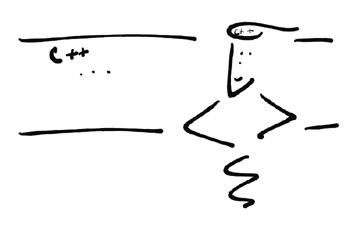
“Remember, use the asterisk to declare pointer variables. You can declare a pointer to any type of object, even user-defined objects. You’ll learn how to do that in chapter 10.
You can use the & operator to get the address of an object so it can be assigned to a pointer. Later, I’ll show you how to use the new operator to create objects out of thin air!”
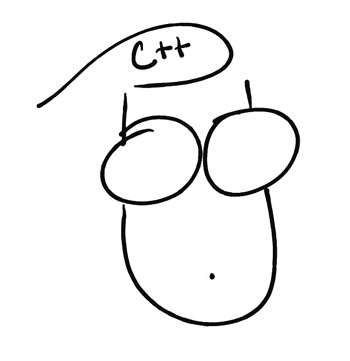
C++ Man continued. “I can see from your hair that you’re beginning to understand pointers much better than before!”
Perplexed One wondered what C++ Man was talking about but was too busy writing notes to check his hair.
“I’m ready to discuss the next question C++ Man” Perplexed One said, pulling out another piece of paper.
How do you access the object a pointer points to?
“This is where things get a little tricky” C++ Man started. Perplexed One looked nervous. “Don’t worry, Perplexed One, it will all make perfect sense when we’re done. Remember, a pointer will contain an object’s memory address. You can get to the object itself with the help of the * operator.” Perplexed One’s eyes glazed over.
“This is confusing” Perplexed One said defiantly. “The asterisk is already used to declare pointers.
“You’re right,” C++ Man said, “but I’ll show you how you can easily remember the difference between using the asterisk for declaring pointers and dereferencing them.”
“OK, show me” Perplexed One said, sitting ready to copy notes.
“Examine the following code” C++ Man said as he waived his hand at the board.
Listing 7.4: dereferencing pointers
1 int a = 3; 2 int* int_ptr = &a; 3 4 cout<<" a = "<<a<<endl; 5 cout<<"Address of a = "<<&a<<endl; 6 cout<<" int_ptr = "<<int_ptr<<endl; 7 cout<<" a = "<<*int_ptr<<endl;
“One line 2, the asterisk appears to the right of the data type when you declare a pointer variable. When you use the * operator to dereference a pointer the asterisk appears to the left of the pointer as shown on line 7.”
Perplexed One’s eyes brightened immediately. “That’s all there is to it?”
“Yep, that’s about it.” Here’s another example:
Listing 7.5: dereferencing pointers
1 int a = 3; 2 int* int_ptr = &a; 3 cout<<" a = "<<a<<endl; 4 *int_ptr = 4; 5 cout<<" a = "<<a<<endl; 6 (*int_ptr)++; 7 cout<<" a = "<<a<<endl;
Perplexed One studied the code on the board.
“As you can see,” C++ Man began, “the variable a is initialized to 3 on line 1. On line 2 the variable int_ptr is declared and initialized to the address of a using the & operator. From that point on, all modifications to variable a can be effected via the pointer with the help of the * operator. Notice how the * operator appears on the left side of the pointer variable. On line 4 the pointer is used to change the value of a from 3 to 4. Line 6 shows how parentheses can be used along with the * operator to help force operator precedence. Running example 7.5 produces the results shown in figure 7-8.”
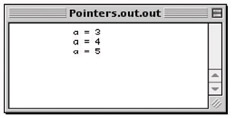
Figure 7-8: Running Example 7.5

When the asterisk appears to the right of a data type it is being used to declare a pointer vari-able. When the asterisk is applied to the left side of a pointer it is called dereferencing and is the way you access the object the pointer is pointing to.

“That seems too easy, there must be a catch.” Perplexed One stated confidently.
“Nope,” replied C++ Man. “there’s no catch. It’s just spine-tingling isn’t it?”
“Isn’t what?” Perplexed One asked, look-ing more perplexed.
“Why, all the fun we’re having with pointers! Prepare for the next topic.”
How do you dynamically create and delete objects?
“Now you’re really going to learn some cool stuff!” C++ Man began. Perplexed One was ready and felt confident he’d understood everything up to this point, and they were over half way though the list of questions. “So far so good” he thought to himself, pencil poised to scribble with wild abandon. C++ Man began again.
“Up to this point you’ve seen how the address of a statically allocated object can be determined with the & operator. You’ve seen how pointer variables can be declared and used to modify the object they point to. The real power of pointers comes from being able to dynamically create objects when a program is running, also referred to as run time or dynamic object allocation. Before I talk about the use of the new operator I want to discuss the two different kinds of memory a program has access to, namely, the stack and the heap.”
“You’ve seen stack memory in action in listing 7-1. The program in example 7.2 used stack memory to store the value of the variable a. Stack memory works well in this case because all the program’s storage needs were determined at compile time.”
“When a program does not know up front how much storage it needs it must dynamically allocate memory during run time from an area of memory known as the heap. The heap is managed by the operating system. A program makes requests to the operating system for memory space and, if there is enough space available on the heap, the memory is reserved and an address is returned to the program.”
“Figure 7-9 shows where stack and heap memory are located with respect to one another in a computer’s memory space.”
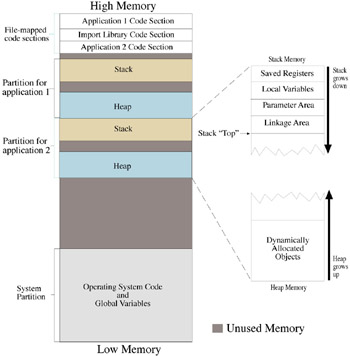
Figure 7-9: Application Stack and Heap Relationship
When the operating system loads a program it sets up an application partition. The partition will be organized into two sections, namely, the stack and the heap. During program execution the stack will grow downwards as functions are called and upwards as functions return to the calling routines. The heap will grow upwards and downwards as dynamically allocated objects are created and destroyed. When an application requests dynamically allocated memory it is carved out of its application partition’s heap section.”
The new Operator
“The new operator is used to dynamically allocate objects during program runtime. The new operator makes a request for heap memory space to the operating system and, if memory is available, will return the newly created object’s memory address. In the case of complex objects like structures and classes, the address returned will be the start of the object’s memory region.”
Difference Between new and new[]
“There are two types of new operator: new, and new[]. The new operator is used to create singular object instances. The new[] operator is used to create arrays of objects.” (The new[] operator is discussed in detail in chapter 8.)
Format of the new Operator
“The new operator takes the following format:”
![]()
Using the new Operator
C++ Man waived his hand at the board and the following source code appeared:
Listing 7.6: dynamic memory allocation
1 int* int_ptr; 2 int_ptr = new int; 3 *int_ptr = 0; 4 5 cout<<"The reserved address is: "<<int_ptr<<endl; 6 cout<<"The value of the int object is: "<<*int_ptr<<endl; 7 8 delete int_ptr;
Perplexed One studied the code intensely and quickly copied it into his notebook. C++ Man began his explanation. “On line 1 I declared a pointer variable named int_ptr to hold the address returned by the new operator. On line 2 the new operator is used to create an object of type int. The address returned is assigned to int_ptr, which is then used on line 3 to access the integer object itself.”

C++ Man summarized, “Dynamic object allocation is a way to create objects in memory at program runtime. The new operator will request memory from the operating system and return a memory address you can use in your program. Dynamic objects are created in an application’s heap memory.”
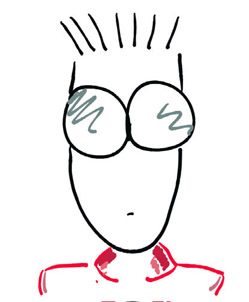
“What does line 8 in example 7.6 do?” Perplexed One asked, looking up from his notes.
“Good question Perplexed One” he began. “When you’re finished with a dynamically allocated object you must remember to release the memory back to the operating system. Failure to do so will result in a mem-ory leak.
”Perplexed One liked the sound of the term memory leak. He thought it was cool.
The Difference Between delete and delete[]
C++ Man pointed once again to the code on line 8 in example 7.6. “There are two types of delete operators” he began. “The delete operator, shown here, is used with the new operator, and is used to release the memory assigned to singular objects back to the operating system.”
“The delete[] operator is used to delete memory dynamically assigned to an array via the new[] operator. A detailed discussion on the delete[] appears in chapter 8.”
A Neat Trick: Calling Object Constructors
“I want to show you something you’ll find helpful when using the new operator” C++ Man told Perplexed One. Perplexed One looked at the board just as C++ Man was waving his hand, causing the following code to appear:
Listing 7.7: calling object constructor
1 int* int_ptr; 2 int_ptr = new int(0); //Constructor call 3 4 cout<<"The reserved address is: "<<int_ptr<<endl; 5 cout<<"The value of the int object is: "<<*int_ptr<<endl; 6 7 delete int_ptr;
“Study the difference between example 7.6 and 7.7. In example 7.6 the object was initialized via the pointer after it was created in memory. In example 7.7 the object is initialized when it is created via a constructor function call. A constructor is a special function whose purpose is to properly initialize objects when they are created in memory. The integer constructor is invoked by enclosing an integer value in parentheses after the type name int when used with the new operator as shown on line 2 above. Other fundamental data types can be initialized in similar fashion.” (Constructors are formally covered in chapters 10 and 11.)
“Here’s another example Perplexed One” C++ Man said, looking toward the board.
Listing 7.8: calling object constructo
1 int* int_ptr = new int(7); 2 char* char_ptr = new char('e'); 3 4 cout<<" The int value is: "<<*int_ptr<<endl; 5 cout<<"The char value is: "<<*char_ptr<<endl; 6 7 delete int_ptr; 8 delete char_ptr;
What’s the difference between a pointer and a reference?
Perplexed One was eager to continue the lesson and started a new sheet of notes. C++ Man waived his hand at the board and removed all the code so there would be nothing to confuse Perplexed One.
“The basic thing to remember about a pointer is that it is a variable. Because a pointer is a variable, it can be changed to point to different objects of the same type.”
“A reference is different from a pointer in that once a reference is initialized it cannot be changed. Another good way of thinking about a reference is that it is a nickname for the object it references. A nickname is just another name for the same object. Pointers must be dereferenced to gain access to the object they point to. Not so with references.”
C++ Man waived his hand at the board and table 7-1 appeared. Perplexed One took notes furiously.
| Characteristic | Pointers | References |
|---|---|---|
| Variable | Yes | No |
| Must be initialized at the point of declaration | No | Yes |
| Must be dereferenced with the * operator | Yes | No |
| Can be thought of as another name for the referenced object | No | Yes |
| Can be used in place of pointers to reduce errors and simplify code | No | Yes |
How do you declare and use references?
Perplexed One looked worried. C++ Man asked him what was the matter. “This is where things get tricky” Perplexed One said, fidgeting at his desk.
“Fear not, Perplexed One,” C++ man said assuringly, “all you have to remember is when to use the & operator. Can you tell me, from what you’ve learned so far, when you would use the & operator?”
Perplexed One studied his notes and answered timidly. “When you want to find an object’s memory address?”
“That’s exactly right!” C++ Man said, flying a victory circle in front of the room. “Now there’s another use for the &. Tell me Perplexed One, how do you declare a pointer variable?”
“You have to use the asterisk between the data type and the identifier.” Perplexed One answered, this time with more confidence.
“Right again!” C++ Man said, waiving his hand at the board. “Take a look at this code:”
Listing 7.9: using a reference
1 int a = 3; 2 int& ref_a = a; 3 4 cout<<" a = "<<a<<endl; 5 cout<<"ref_a = "<<ref_a<<endl;
“Notice how the & is used on line 2 to declare a reference type. The identifier ref_a can now be used in place of the identifier a without any dereferencing, as is shown on line 5.”
“References come in handy when you’re passing function parameters by reference or returning objects by reference from functions. Functions will be discussed in detail in chapter 9.”
Perplexed One felt relieved. “That doesn’t seem so hard!” he said, finishing his notes.
C++ Man hovered in front of the class. “Your basic understanding of pointers and references will serve you well as you progress through your studies of C++ Perplexed One. Why don’t you summarize all your pointer knowledge before I have to fly and help another perplexed student.”
|
| < Day Day Up > |
|
EAN: 2147483647
Pages: 340